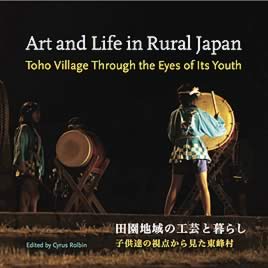Toho Village Through the Eyes of Its Youth
Edited by Cyrus Rolbin
 |
|
| SOFTCOVER: | |
| HARDCOVER: | |
May 2010 ♦ Softcover ♦ 176 pages, 194 four-color photographs ♦ ISBN: 978-0-9815595-3-7
♦ $24.95 (USD) | Hardover ♦ ISBN: 978-0-9815595-4-4 ♦ $29.95 (USD)
ORDER NOW! Click on the "Buy Now" button below the book cover, depending upon whether you would like the soft or hard cover version. For orders of ten books or more, please contact info@nextgenerationpress.org for bulk purchase discounts.
IN A REMOTE MOUNTAIN VILLAGE CALLED TOHO, unknown to most in urbanized Japan, an unlikely group—the local children—has published a book to open the eyes of the world. Art and Life in Rural Japan presents a vivid portrait of life in depopulating Japan through the eyes of its youngest residents.
In stunning photographs and simple first-person narrative (presented in both English and Japanese), the children of Toho make clear that they would like to stay there forever. Yet the odds are against it. Children under 15 made up only 13 percent of Japan’s population in 2009. And in rural villages with declining economies, the plunge is even starker.
Their elementary school is closing, after more than 100 years of educating their forebears. A single yellow train chugs daily across three “eyeglass bridges” linking Toho village with the outside world. Unrelated families form close bonds to eat and play together with their treasured young ones.
Created in 2005 when two neighboring villages combined for a federal tax advantage, Toho holds 2,749 residents in its 20 mountainous miles, making it the smallest such “merged village” in Japan. One party to the merger was Koishiwara, renowned for its traditional stoneware pottery made for 400 years out of the rich local clay. The other, Hoshuyama, is famous for its terraced rice fields and clear spring waters.
The children describe their local traditions in loving detail. Their words and photos record the potters using 17th century techniques to craft beautiful mingei stoneware for everyday use. (Some are closing their kilns for want of children to take their places.) They show us the cycle of the rice harvest from the newly planted sprigs of May to late September, when plants hang on long racks to dry in the sun. We see the folkloric statues carved from centuries-old giant cedars felled in a historic typhoon 20 years ago. We watch kids catching frogs in rice fields, and practicing on taiko drums to perform at the summer festival, as did generations of children before them.
Powerful and poignant, Art and Life in Rural Japan is a treasure of local history, above all. Yet its dual-language presentation also entices learners of either Japanese or English to follow along in the new language with eager interest.
The book emerged from a project carried out by a Harvard-trained educator, Cyrus Rolbin, in collaboration with WKCD’s worldwide service-learning program known as “In Our Global Village.” Not surprising, then, that its final pages are filled with fun exercises to help readers of all ages recall the lasting lessons that we have learned from our young teachers.
Proceeds from the sale of Art and Life in Rural Japan support education in Toho's remaining school and the tsunami ravaged town of Ongawa.
View flip book excerpts online
School Library Journal, May 2011
"This gem of a book takes readers beyond typical images of Japan as a land of cityscapes and bullet trains, and into the heart of a small mountain community. Dwindling populations have forced villages to merge to sustain themselves economically, resulting in the loss of each community's distinctive character. A foreword explains that the youth of Toho, Japan's smallest merged village, contributed photographs and text to create this book as part of a revitalization effort to document and share their hometown's unique qualities. Simple, often poignant sentences in English and Japanese tell Toho's story, rich in history and culture. Stunning, full-color pictures capture verdant rice fields, jubilant school scenes, a lively festival, and expressive portraits of Toho's residents. The village's connection with its heritage is evident in photographs of its traditional arts, stoneware pottery created using centuries-old techniques and wood carvings made of trees from the local forests. A fascinating window into a vanishing way of life, this book holds appeal for both pleasure reading and reports, and the inclusion of a word search, crossword puzzle, and comprehension quiz adds to its value for educators. This book provides an intimate look at the culture and rhythms of a small, rural Japanese community and is especially relevant right now, as children may want to learn about such villages in the aftermath of the Tohoku earthquake and tsunami."


